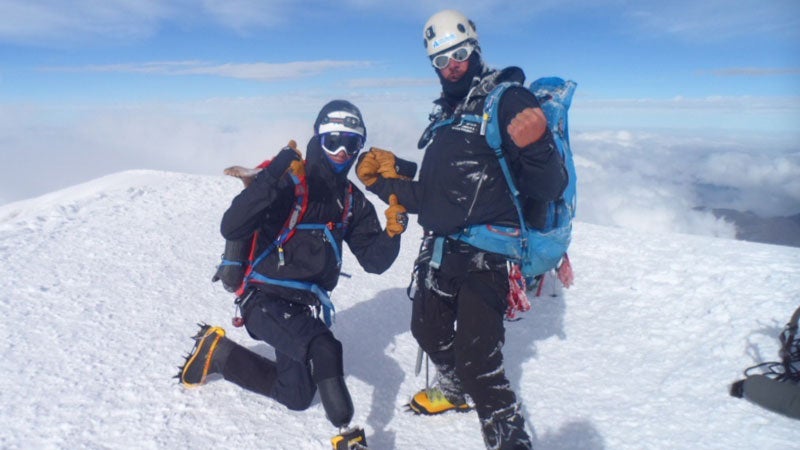Five minutes into my conversation with mountaineer Tim Medvetz, the phone connection drops out. Has the Los Angeles-based Hell’s Angel and star of Everest: Beyond the Limit just snubbed me?
Within seconds, my phone rings again. It’s Medvetz.
“Sorry about that,” he says. “I still haven’t figured out how to handle these iPhones when I get an incoming call. I honestly prefer when I can leave it all behind in the mountains.”
Mountaineering bears far more significance in Medvetz’ life that it does for many of his peers. On September 10, 2001, a truck hit Medvetz as he raced his motorcycle through the San Fernando Valley. The New Jersey native woke up the next morning, partially paralyzed and fighting for his life, to a crowd of doctors and nurses, whose eyes were glued to footage of the burning World Trade Center in the wake of the 9/11 attacks. After months of excrutiating therapy, Medvetz vowed that he would climb Everest as a symbol of his recovery.
In 2006, Medvetz made it within 300 feet of the summit before turning back because his oxygen was running low. The following year he summited, despite falling and shattering his right hand along the way.
These days, Medvetz runs , a nonprofit created to help injured veterans from Iraq and Afghanistan mentally and physically rehabilitate. This May, he’ll attempt to help guide Charlie Linville, a Marine staff sergeant who lost a foot in Afghanistan, to the top of Mount Everest.
Medvetz gave �����ԹϺ��� the rundown about the upcoming Everest trek, his personal struggles, and how he makes a difference in the lives of the wounded veterans he helps.
OUTSIDE: You’ve got something like a pound of metal in your body from all your operations after your accident. How are you feeling these days?
MEDVETZ: I have two metal plates in my head, with ten screws in each plate; a titanium steel cage in my lower spine, wrapped around my side; two metal plates in my right hand, with five screws in each one; a plate with seven screws in my left knee; six screws in my left ankle. My knee has basically been put back together. And my left ankle doesn’t flex.
I also have a 12-inch steel rod through my penis, so I’m constantly walking around with a hard-on. Tell your readers I’m single and need some dates!
We’ll get into the details of The Heroes Project, but I have to ask: Do you plan to summit Everest again?
I’m 250 pounds and 6-foot-5, so I’m the largest man on the Everest summit. After I climbed it the second time I said, “I’m not coming back here again.” But doing these seven summits with seven different amputees, part of that deal is Everest. I made a promise, so here I am, going back again. I’m kind of over it, but I’m pretty excited to see how it looks from the South Side. You get up North and you see the ridge going down to the South Side—it’s an unknown you’re curious about.
These guys have already been through war. Then they say, ‘OK, I’ll take your challenge and climb this mountain.’ They’re already halfway to the summit with their mentality—that’s the easy part actually.
Can you tell me how The Heroes Project came to be?
I climbed Everest in ’07, and the big question after that was, “What’s next?” I started skydiving and scuba diving. I went down to Mexico to climb volcanoes, but nothing filled the void of climbing Everest. I decided to climb the seven summits.
Mountaineering is the most selfish sport in the world, because you’re gone for months on end, and sometimes you don’t come back. When I did Everest it was that, it was selfish, and even more so for me because I was in a wheelchair for six months, and broke every bone in my body first. Doctors told me “You can’t do this” and “You can’t do that.” Everest was a personal thing for me, because I had to prove I could still do things if I set my mind to them.
Everest today gets lots of press. Teams raise money for organizations ranging from world peace or breast cancer. I didn’t want climbing the seven summits to be about me. I wanted to raise money. One Veteran’s Day I was watching TV coverage of an event in a cemetery, and a guy got up on the podium, burned beyond recognition—he didn’t even look human. He had hit a roadside bomb in his Hummer and had basically been roasted alive. He talked about how proud of an American he was, how he didn’t regret one day. It was powerful; it gave me goose bumps. A light bulb went off in my head: “I’m going to help injured vets.” And with 43,000 injured vets since the Iraq invasion, there’s no shortage of injured guys.
Because you only focus on one veteran at a time, how do you choose whom to mentor?
I pick the guys who won’t leave me alone. I throw the opportunity out there and the guy who who annoys the shit out of me and keeps telling me, “I’m your guy,” that’s who I pick. Only a small percentage of guys will take the challenge. It’s not a weekend trip to Vail. When I accept them I ask for their commitment to the journey, because they’ll be training for be six to eight months, every weekend. I also give them a workout program for the week. It’s a big challenge to take on, especially when you’re missing limbs.
How do you help the veterans you work with prepare mentally for these climbs?
These guys have already been through war. Plus, they made the decision to join the military while a fucking war’s going on! That right there takes a lot! Then, boom, they’re missing a leg or two. Then they say, “OK, I’ll take your challenge and climb this mountain.” They’re already halfway to the summit with their mentality, that’s the easy part actually. They already have what it takes.
I take them to places like Denali, where people die every year. I believe they’re going to need more than a weekend of skiing or surfing or fishing to truly rehabilitate and get their lives back. I need to get them in harm’s way, because that’s where the rehabilitation is.
We were on Denali in 2011 and a French guy plummeted to his death right in front of us. Here I am, roped up to a guy missing a leg, and I tell him, “I didn’t start this organization to get anybody killed. If you want to turn back it’s OK, you can back out.” He looked at me and said, “Are you kidding? That’s why I’m here! I finally feel like I’m a Marine again.”
Mountain climbing is the closest thing to putting these veterans back on a battlefield. On a climbing team, when we push for the summit we check our gear and leave in the middle of the night. You need to do certain things to get to the summit—and if you don’t, then things go wrong really fast. People die. People get hurt. It’s the same as when these guys go on missions in the warzone. They make sure they’ve got their ammunition, their flak jackets, their infrared tools. With both, you’re part of a team.
Walk me through the Everest plan. Who’s on the summit team? What outfitter will you use?
There are four of us: me, the vet, the local guide, and the cameraman. We’re using , the same guy I did two years on Everest with. We leave March 25, and we’ll climb from the South Side. I’ve only climbed the North Side, so this’ll be new for me. The whole thing will take basically two months—but that’s all contingent on the weather window.
The vet is Charlie Linville, a U.S. Marine Corps staff sergeant. He was a bomb technician, and diffused 30 to 40 bombs a day in Afghanistan.
Charlie is ready. I’ve been training him for over a year. We were training in Ecuador for a month, climbing different peaks. We just got back from Argentina and Mexico. He’s been out to the Sierras, too. And all his local training in Idaho, of course.
I’m training him not to be the client who the rest of the team does everything for. Charlie is completely capable of assisting in a rescue. He’s a productive member of the team.
What challenges do you anticipate, and do you these differ from the challenges run-of-the-mill climbers face?
Everybody knows that before you leave for a big climb you have to go through your gear list. You’re in the basement checking everything. Sleeping bag? Check. Backpack? Check. Carabiners? Check. Now, with these guys it’s all that and then, “Extra leg? Check.”
And at high altitudes, these guys’ stumps constantly change size! Plus, they can’t take their meds because they’ll mess with their systems. I’ll be gasping for air and then I’ll look at a kid with no legs who’s just motoring up the mountains, through the pain. They help me get up to the summit of these mountains.
Your expedition leader turned you back from your first summit attempt. Are you prepared to do the same for your crew around if things go bad near the top?
I learned a valuable, two-fold lesson in 2006. A. The mountain will be there next year. B. The summit is only halfway. You still have to get back down.
When you’re on a journey with a guy for a year, you hear all the stories. Charlie has been through so much, and he’s fully prepared to do everything he has to do, even if that means getting on his knees and climbing to the summit. But since he’s never been to that altitude, it’ll take me to tell him, “If you’re crawling on your knees, then you have to turn around.”
Where do you see The Heroes Project going from here?
We focus on one guy so we can make a bigger impact, but we film every single climb. The end goal is to get this footage to all the Walter Reed-type hospitals out there, to over 43,000 injured guys.
Most of these guys have never left the country except to go to Iraq or Afghanistan, so taking them on these international climbs is a huge cultural experience. We trekked through Indonesian jungles filled with guys wearing only penis gourds. You’ve got guys from Birmingham, Alabama, saying, “Where am I? This is the coolest thing!”
Many of these guys have the same story: They get out of high school in Podunk, Indiana, live in their mom’s house, enlist, ship off to boot camp, and then Iraq. Then a year later they get blown up, fixed up, and they’re back in Podunk, Indiana, on their mom’s couch, wondering what happened to their legs. We scoop them up, get them off the pills, and ship them off to a foreign country to journey in the mountains. What else would get them out of Podunk, Indiana?
For now, it’s really working. These mountains are having a huge effect. That’s all we wanted from the start.


